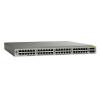-
Kč

Cisco Nexus N3K-C3048TP-1GE is a managed Layer 2/3 switch. It is equipped with 48 gigabit Ethernet ports (10/100/1000 Mb / s) and 4 SFP + slots (1/10 Gb / s). The device has a housing suitable for installation in a 19 "rack, the height is 1U. It has 2 power supplies that work redundantly - in the event of a failure, one of the other is responsible for the power supply. Available power options: 2x AC adapter (100 - 240 V AC), 2x power supply DC (40 - 72 V DC) or AC + DC power supply.
The maximum switching bandwidth is 176 Gb / s and the packet forwarding rate is 132 Mp / s. The switch supports many Layer 3 routing functions, including BGP and OSPF. In addition, it has all the necessary Layer 2 functions and is perfect for multicast support.
LAN Enterprise License N3K-LAN1K9
The most important features:
- 48 gigabit Ethernet ports;
- 4 SFP + slots (1/10 Gb / s);
- switching capacity: 176 Gb / s;
- packet forwarding speed: 132 Mp / s;
- Layer 2 and 3 management;
- BGP and OSPF;
- DC power supply.
Specification:
| Nexus N3K-3048TP-1GE | |
| General features |
19 "1U Rack Case 48 Gigabit Ethernet Ports 10/100/1000 Mb / s 4 SFP + slots 1/10 Gb / s 2 redundant power sources Fan |
| Efficiency |
Switching bandwidth: 176 Gb / s Packet forwarding speed: 132 Mp / s Line-rate traffic on all ports (Layer 2 and 3) MTU - 9216 (jumbo frames) |
| Hardware Properties | |
|---|---|
| MAC addresses | 128k entries |
| VLANs | 4096 |
| Spanning-tree instances |
RSTP: 512 MSTP: 64 |
| ACL entries |
2000 ingress 1000 egress |
| Routing table |
16000 prefixów / 16000 host entries 8000 multicast routes (data depends on the software version) |
| Number of EtherChannels | 52 (z vPC) |
| Number of ports on EtherChannel | 16 |
| Buffer | 9 MB (share) |
| Boot flash memory | 2 GB |
| Power | |
| Number of power supplies | 2 |
| Type of power supplies | AC |
| Average power consumption | 120 W at 100% load |
| Maximum power consumption | 124 W |
| AC power supply |
100 - 240 V DC 50 - 60 HZ Efficiency 89 - 91% at 220 V |
| Average heat dissipation |
409 BTU/hr (100% load) |
| Maximum heat dissipation | 423 BTU/hr |
| Other and environmental features | |
| Volume |
Fan at 40%: 63.9 dBA Fan at 60%: 64.7 dBA Fan at 100%: 66.4 dBA |
| Dimensions |
Height: 4.4 cm Width: 43.9 cm Depth: 50.5 cm |
| Weight | 9,3 kg |
| Operating temperature | 0 to 40 °C |
| Storage temperature | -40 to 70 °C |
| Operating humidity |
10% -85% non-condensing At maximum humidity, the switch can work for up to 5 days |
| Storage humidity | 5%-95% non-condensing |
| Software fatures | |
| Layer 2 | Layer 2 switch ports and VLAN trunks IEEE 802.1Q VLAN encapsulation Support for up to 4096 VLANs Rapid per-VLAN Spanning Tree Plus (PVRST+) (IEEE 802.1w compatible) MSTP (IEEE 802.1s): 64 instances Spanning Tree PortFast Spanning Tree Root Guard Spanning Tree Bridge Assurance vPC Cisco EtherChannel technology (up to 16 ports per EtherChannel) LACP: IEEE 802.3ad Advanced PortChannel hashing based on Layer 2, 3, and 4 information Jumbo frames on all ports (up to 9216 bytes) Storm control (unicast, multicast, and broadcast) PVLANs |
| Layer 3 | Layer 3 interfaces: Routed ports on interfaces, switch virtual interfaces (SVIs), PortChannels, and subinterfaces (total = 1024) 32-way ECMP 2000 ingress and 1000 egress ACL entries Routing protocols: Static, RIP v2, EIGRP, OSPFv2, and BGP Bidirectional Flow Detection (BFD) for BGP HSRP and VRRP ACL: Routed ACL with Layer 3 and 4 options to match ingress and egress ACLs VRF: VRF-lite (IP VPN), VRF-aware unicast (BGP, OSPF, and RIP), and VRF-aware multicast uRPF with ACL; strict and loose modes Jumbo frame support (up to 9216 bytes) |
| Multicast |
Multicast: PIM-SM Version 2 and SSM Bootstrap router (BSR), Automatic Rendezvous Point (Auto-RP), and Static RP MSDP and Anycast-RP Internet Group Management Protocol (IGMP) Versions 2, and 3 |
| Quality of service (QoS) |
Layer 2 IEEE 802.1p (class of service [CoS]) 8 hardware queues per port Per-port QoS configuration CoS trust Port-based CoS assignment Modular QoS CLI (MQC) compliance ACL-based QoS classification (Layers 2, 3, and 4) MQC CoS marking Differentiated services code point (DSCP) marking Weighted Random Early Detection (WRED) CoS-based egress queuing Egress strict-priority queuing Egress port-based scheduling: Weighted Round-Robin (WRR) Explicit Congestion Notification (ECN) |
| Protections | Ingress ACLs (standard and extended) on Ethernet Standard and extended Layer 3 to 4 ACLs: IPv4, Internet Control Message Protocol (ICMP), TCP, User Datagram Protocol (UDP), etc. VLAN-based ACLs (VACLs) Port-based ACLs (PACLs) Named ACLs ACLs on virtual terminals (vtys) DHCP snooping with Option 82 Port number in DHCP Option 82 DHCP relay Dynamic Address Resolution Protocol (ARP) inspection CoPP |
| Cisco Nexus Data Broker | Topology support for tap and SPAN aggregation Support for QinQ to tag input source tap and SPAN ports Traffic load balancing to multiple monitoring tools Traffic filtering based on Layer 1 through Layer 4 header information Traffic replication and forwarding to multiple monitoring tools Robust RBAC Northbound Representational State Transfer (REST) API for all programmability support |
| Management | Switch management using 10/100/1000-Mbps management or console ports CLI-based console to provide detailed out-of-band management In-band switch management Locator and beacon LEDs Port-based locator and beacon LEDs Configuration rollback SSHv2 Telnet AAA AAA with RBAC RADIUS TACACS+ Syslog Syslog generation on system resources (for example, FIB tables) Embedded packet analyzer SNMP v1, v2, and v3 Enhanced SNMP MIB support XML (NETCONF) support Remote monitoring (RMON) Advanced Encryption Standard (AES) for management traffic Unified username and passwords across CLI and SNMP Microsoft Challenge Handshake Authentication Protocol (MS-CHAP) Digital certificates for management between switch and RADIUS server Cisco Discovery Protocol Versions 1 and 2 RBAC Cisco Switched Port Analyzer (SPAN) on physical, PortChannel and VLAN interfaces Encapsulated Remote Switched Port Analyzer (ERSPAN) Ingress and egress packet counters per interface PTP (IEEE1588) boundary clock Network Time Protocol (NTP) Cisco OHMS Comprehensive bootup diagnostic tests Cisco Call Home Cisco DCNM Advanced buffer monitoring |
| MIB |
Generic MIBs ● SNMPv2-SMI ● CISCO-VLAN-MEMBERSHIP-MIB ● ENTITY-MIB Monitoring MIBs ● NOTIFICATION-LOG-MIB ● CISCO-AAA-SERVER-MIB ● CISCO-LICENSE-MGR-MIB ● UDP-MIB |
| Standards | IEEE 802.1D: Spanning Tree Protocol IEEE 802.1p: CoS Prioritization IEEE 802.1Q: VLAN Tagging IEEE 802.1s: Multiple VLAN Instances of Spanning Tree Protocol IEEE 802.1w: Rapid Reconfiguration of Spanning Tree Protocol IEEE 802.3z: Gigabit Ethernet IEEE 802.3ad: Link Aggregation Control Protocol (LACP) IEEE 802.3ae: 10 Gigabit Ethernet IEEE 802.1ab: LLDP IEEE 1588-2008: Precision Time Protocol (Boundary Clock) |
| RFC |
BGP ● RFC 1997: BGP Communities Attribute ● RFC 2328: OSPF Version 2 ● RFC 1724: RIPv2 MIB Extension ● RFC 2236: Internet Group Management Protocol, version 2 |
| Safety | UL 60950-1 Second Edition CAN/CSA-C22.2 No. 60950-1 Second Edition EN 60950-1 Second Edition IEC 60950-1 Second Edition AS/NZS 60950-1 GB4943 |
| EMC |
47CFR Part 15 (CFR 47) Class A EN55024 |






 Polski
Polski English
English Italiano
Italiano Español
Español Čeština
Čeština Српски
Српски Deutsch
Deutsch Ελληνικά
Ελληνικά Slovenský
Slovenský




